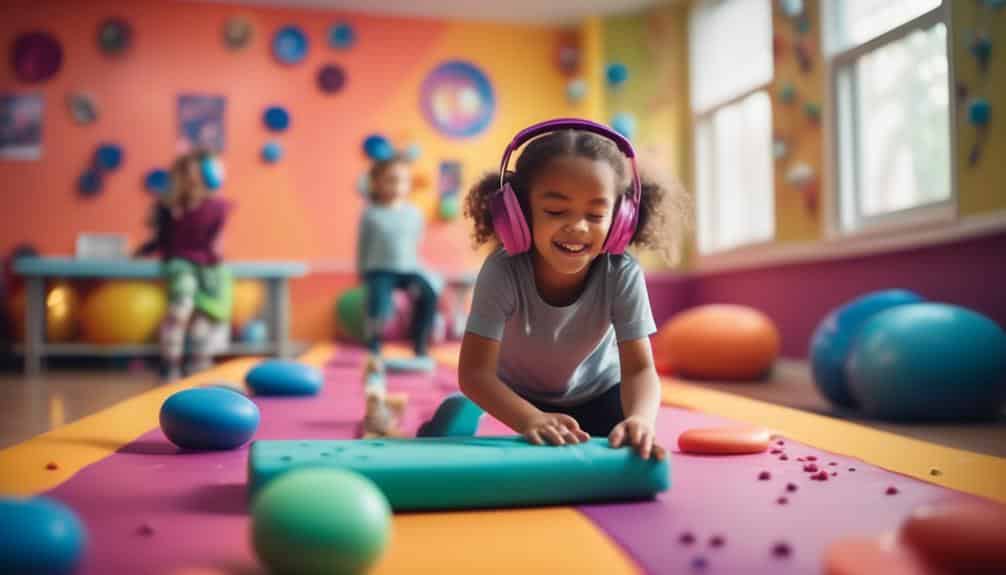Navigating the world with Sensory Processing Disorder (SPD) can sometimes feel like trying to tune a radio while grappling with a thousand dials—all at once. You’re constantly adjusting to the barrage of sensory information, and it’s not just overwhelming; it can be downright exhausting. But there’s good news: specific therapy exercises have been shown to ease the sensory chaos significantly. Imagine having a toolbox of sensory processing therapy exercises to help you or your child recalibrate and engage with the environment more comfortably and controlled. Each exercise offers a unique path to sensory integration, from the soothing rhythms of brushing therapy to the grounding effects of joint compression. Yet, as you stand at the threshold of these transformative practices, you might wonder which will be the key to unlocking a sense of balance and tranquility in your sensory world. Let’s explore together, as each exercise brings its promise of discovery and potential for a calmer sensory experience.
Key Takeaways
- Sensory integration techniques, such as brushing therapy and joint compressions, can enhance proprioceptive awareness and sensory integration.
- Vestibular stimulation activities like swinging and spinning activate the vestibular system and promote core stability and coordination.
- Auditory processing activities like listening games can improve auditory discrimination and memory skills.
- Visual-motor coordination drills, like dot-to-dot puzzles, can enhance hand-eye coordination and fine motor skills.
Brushing Therapy Techniques
Brushing therapy techniques harness a specialized brush to deliver firm tactile stimulation and enhance sensory integration and proprioceptive awareness in individuals with sensory processing disorder (SPD). As an occupational therapist, you’ll find that incorporating these methods into a comprehensive sensory integration program can be pivotal in regulating your clients’ sensory processing and improving their body awareness.
This approach utilizes deep pressure input to the skin, which can be particularly beneficial for those who experience dysregulation of the sensory systems, including the vestibular system. The intention is to provide a grounding sensation through consistent, structured touch. When paired with joint compressions, brushing therapy can offer a calming sensory input that helps to soothe and organize the nervous system.
You must receive proper training in these brushing therapy techniques to ensure they’re executed effectively and safely. This safeguarding step ensures that the proprioceptive input is delivered in a manner that supports the individual’s sensory needs without causing undue stress or discomfort.
Joint Compression Exercises
Building on the foundation of brushing therapy, joint compression exercises enhance proprioceptive feedback and sensory integration (SPD) for individuals with Sensory Processing Disorder. As you delve into Occupational Therapy, these exercises are vital in helping children with sensory processing issues. The key aim is to aid the vestibular system by providing consistent, deep sensory input through heavy work activities.
Joint compression exercises, when executed correctly, can have a significant impact. They involve applying gentle pressure to the child’s joints, effectively sending signals to the brain that help to organize sensory information. This can lead to improved body awareness and coordination. When working with children, it’s crucial to tailor these exercises to their needs and tolerance levels.
Remember, consistency and repetition are paramount. It would be best to integrate joint compression exercises into the child’s daily routine, which may include other heavy work activities. These routines can be the cornerstone of a sensory diet to support their unique sensory integration needs.
In your practice, you’ll learn that these exercises don’t just provide immediate sensory input; they also play a long-term role in helping children to process better and respond to the sensory stimuli in their environment.
Vestibular Stimulation Activities

You’ll find that integrating vestibular stimulation activities such as swinging and spinning exercises into therapy can significantly enhance proprioceptive feedback and spatial orientation for children with sensory processing disorder. Incorporating balance board challenges offers a practical approach to improve core stability and coordination. Additionally, rhythmic movement training can be particularly beneficial in synchronizing sensory systems and promoting neural integration.
Swinging and Spinning Exercises
Swinging and spinning exercises can significantly enhance vestibular stimulation, supporting the body’s understanding of movement and spatial orientation. These exercises activate the vestibular system, particularly the vestibular receptors in the inner ear, which play a critical role in sensing motion and maintaining balance. For a child with sensory processing challenges, Occupational Therapy often includes swinging and spinning exercises to stimulate the vestibular system. Calming or stimulating sensory input can help children with sensory integration issues. When implementing these activities, it’s essential to tailor the approach to each child’s unique needs. Some children may find these exercises exhilarating, while others might need gradual exposure. Always prioritize the child’s comfort and be responsive to their cues.
Balance Board Challenges
While swinging and spinning exercises stimulate the vestibular system, incorporating balance board challenges can improve balance and coordination. Enhancing bilateral coordination and motor skills is crucial for individuals with Sensory Processing Disorder. Occupational therapy often employs these exercises to support sensory integration, utilizing the input to the inner ear to aid in developing a robust vestibular system.
Here’s a simple guide for balance board activities:
| Activity | Objective | Tips |
|---|---|---|
| Standing Still | Improve static balance | Keep feet shoulder-width apart |
| Rocking | Enhance dynamic balance | Gently shift weight from side to side |
| Weight Shifting | Foster body awareness | Move weight from heels to toes |
Integrate these balance board challenges at home to reinforce the progress made in Occupational Therapy sessions, offering continuous vestibular stimulation and motor skill enhancement.
Rhythmic Movement Training
Delve into Rhythmic Movement Training, a sequence of gentle, rhythmic exercises designed to stimulate your vestibular system and enhance sensory integration. These therapy activities, integral to sensory processing improvement, can benefit a child requiring Occupational Therapy.
- Rocking Chair Exercises
- Gently rock back and forth, calming the nervous system.
- Integrate into reading sessions to pair comfort with learning.
- Gradually increase rocking speed to challenge balance.
- Rolling Movements
- Encourage rolling sideways on a mat, promoting vestibular stimulation.
- Use soft lighting to maintain a relaxed environment.
- Increase complexity by adding a target to reach.
- Swinging Activities
- Utilize a therapy swing to provide controlled vestibular input.
- Start with slow, predictable swinging, progressing in varied directions.
- Incorporate playful themes to engage the child’s interest.
Incorporating these exercises into a child’s routine can improve sensory processing capabilities.
Proprioceptive Input Strategies

To enhance body awareness and coordination, proprioceptive input strategies utilize activities that apply deep pressure, joint compression, and muscle resistance. These techniques are particularly beneficial for a child with SPD (Sensory Processing Disorder), as they help improve the brain’s ability to process sensory information from the muscles and joints. Occupational Therapists often recommend heavy work activities such as pushing a heavy trolley or climbing on playground equipment because they provide essential sensory stimulation.
Furthermore, deep-pressure activities like wearing weighted vests or snuggling under weighted blankets can comfort and calm overstimulated children. These tools reorganize their emotions and behavior by providing consistent sensory input. In addition, engaging in yoga poses, rolling up in a blanket, or pushing a vacuum cleaner can all be effective proprioception activities that help children discern the position and movement of their bodies in space.
These proprioceptive input strategies help children with SPD feel their muscles and joints working harmoniously and integrate that sensory information into a coherent whole. Through these exercises, children can achieve improved body awareness and self-regulation.
Auditory Processing Activities
Auditory processing activities are essential exercises designed to enhance your ability to interpret and respond to sounds, which can be particularly beneficial for individuals with Sensory Processing Disorder. These activities aim to improve auditory discrimination, figure-ground discrimination, and auditory memory skills, allowing you to focus better and respond to the aural environment around you.
Incorporating the following auditory processing activities into your routine can help your child develop visual and auditory skills:
- Listening Games
- *Simon Says* to hone in on auditory commands
- *Musical Chairs* to process auditory cues and react quickly
- *Sound Matching* games to differentiate between similar sounds
- Sensory Sound Box
- Collecting objects that produce distinctive sounds
- Encouraging your child to identify items by their auditory output alone
- Pairing the sounds with visual representations to reinforce connections
- Music-Based Activities
- Dancing to Music
- Allows for expression through movement while processing rhythms
- It helps in distinguishing between different musical instruments and sounds
- Creating music with instruments to understand pitch and volume
- Using noise-canceling headphones to reduce loud noises and focus on specific auditory inputs
Visual-Motor Coordination Drills

Harnessing the connection between sight and movement, visual-motor coordination drills are crucial for enhancing the synchronization of one’s visual perception with one’s physical actions. These sensory processing disorder therapy exercises are designed to help kids improve the essential skills necessary for tasks that demand fine motor precision and visual-motor integration.
Incorporating these activities into a child’s routine can significantly affect their ability to process sensory information effectively. Children benefit greatly from structured exercises that challenge and develop their visual-motor skills.
Below is a table outlining several visual-motor coordination drills that you can use to support children with sensory processing challenges:
| Activity | Description |
|---|---|
| Dot-to-Dot Puzzles | These encourage the child to connect dots sequentially, enhancing hand-eye coordination. |
| Tracing Shapes | Tracing assists in refining motor control and understanding spatial relationships. |
| Mazes | Navigating mazes requires planning and the ability to adjust movements based on visual cues. |
| Ball Activities | Catching, throwing, and hitting targets improve dynamic visual tracking and coordination. |
These activities are practical, accessible, and easily adapted to suit the individual needs of each child you’re working with. It’s important to remember that consistent practice leads to the best outcomes in developing visual-motor coordination.
Tactile Discrimination Games
Engaging in tactile discrimination games, children with sensory processing disorder can sharpen their ability to identify and differentiate textures and objects solely through touch. These games are pivotal for extra sensitive or seeking tactile input, as they offer a controlled and therapeutic method to engage with different textures.
Imagine the focused concentration as a child reaches into a mystery box:
- *Mystery Box Challenge*
- The velvety softness of a piece of fabric
- The excellent, hard surface of a marble
- A squishy ball’s surprising give under pressure
Consider the creativity sparked by manipulating play dough:
- *Play Dough Creations*
- Rolling smooth snakes or bumpy caterpillars
- Pressing objects to create imprints
- Sculpting figures that range from slick to textured
Envision the excitement of a sensory scavenger hunt:
- *Sensory Scavenger Hunt*
- Seeking items with varied textures, like a fluffy feather or a piece of bark
- Collecting objects with different temperatures
- Gathering items of assorted weights and sizes
Through these tactile discrimination games, you’ll facilitate the development of fine motor skills and sensory awareness, providing a practical approach to therapy for children with sensory processing disorder.
Frequently Asked Questions
What Is the Best Therapy for Sensory Processing Therapy?
The best therapy for sensory processing disorder depends on your child’s specific needs. Occupational therapy, tailored sensory activities, and integration exercises are often practical in addressing and managing SPD symptoms.
Do Sensory Processing Disorder Therapy Exercises Help?
Exercise can significantly soothe sensory struggles, bolstering balance and brain function to manage sensory input better and fostering functional finesse in facing daily demands. It’s a complementary component of clinical care.
How Can I Improve My Sensory Processing Disorder?
To improve your sensory processing disorder, integrate daily activities like sensory bins, log roll yoga, and deep pressure techniques to enhance coordination, calmness, and sensory integration for more effective management.
What Are the Best Activities for Sensory Avoiders?
Imagine wrapping yourself in a cocoon of calm; you might find deep-pressure activities, like weighted blankets, ideal for sensory avoiders seeking a haven from overwhelming stimuli.
Conclusion
Sensory processing challenges can affect hundreds of children, including those with autism spectrum disorder, Picky Eaters, and individuals with cerebral palsy or developmental delays. Sensory diets and Sensory integration activities can help address sensory processing issues. Engaging in activities that provide sensory input can help children improve their sensory processing skills and behaviors.
Many fun activities can provide sensory experiences for children. Trampolines, exercise, and therapy balls can offer vestibular input and improve balance and postural stability. Deep pressure activities, such as using stress balls or cotton balls, can provide tactile input and help with tactile defensiveness. Joint compressions and Proprioceptive Activities can provide proprioceptive input and improve motor planning and oral motor control.
Sensory Motor Skills can be developed through challenging activities that offer heavy work input and resistive muscle activity. Some preferred activities for children include ball pits, puzzle pieces, and body socks. Therapeutic exercises can help build strength, core stability, and sensory stimulation.
Skill PointTherapy offers occupational therapy services and resources for children with sensory processing difficulties. They provide a therapy plan that includes advanced activities for kids, progressive exercises, and daily living activities. They also offer affiliate links to resources that can be used regularly to improve the sensory behavior of individuals with autism.
Raising A Sensory Smart Child is a helpful book that explains how the senses affect our arousal levels. It guides how to find the optimal level of stimulation for individuals and how to manage noise levels. With the correct type of therapy and sensory-related activities, individuals with autism can improve their sensory processing skills and social skills.


Recent Comments